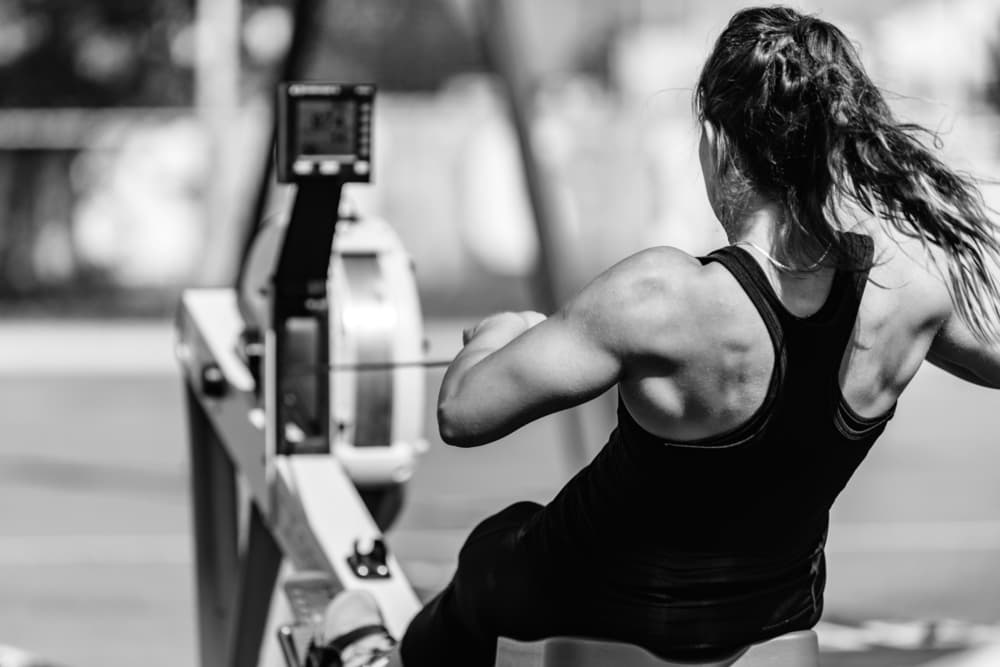
Rowing is becoming more and more popular with the rise of CrossFit, box gyms, and other high-intensity workouts. It can provide fantastic full-body training but can be quite technical. Performing rowing incorrectly can result in injury. Correct form can increase the intensity of your workout, build lean muscle, and increase stamina and speed.
There are two central positions we will discuss in the article: the catch and the pull. The catch position is the position that starts each rowing stroke, where the knees are bent, arms are straight, and the body is close to the flywheel or damper. The pull position is when legs are fully extended, and arms are bent, with the handle contacting the chest.
Are you rowing correctly on your rowing machine? Let’s find out. Here are 6 common rowing mistakes that you’re probably making.
Collapsing at the Knees
One of the common mistakes we see when rowing is the knees collapsing together, either in the catch or during the pull. This can be problematic because rowing is all about efficiency and power. When the knees are collapsing, that means the quads and posterior chair are not firing as powerfully as if the knees are pushing away from each other. This can also cause rounding of the back, which can strain the back over time if it is not engaged. Next time you row, be sure your knees are tracking in line with your feet and drive through your heels, and you pull.
Rounding the Back
After you perform a powerful pull on a rowing machine, it can be tempting to relax your shoulders and back to recover as you go in for the catch position. However, rounding the back can lead to an incorrect and less efficient pull. Keep shoulders down and back and keep a lumbar curve in the spine the entire time you are rowing to get the most out of your workout.
Pulling with Bent Arms
One of the most common mistakes people make is attempting to pull on their rower with bent arms. Pulling with bent arms will put your power out of balance and cause you to do most of the pulling with the upper body, when in reality, the proper way to pull is by driving through the heels, engaging the glutes and core, and pulling with straight arms for as long as possible. Bending of the arms should only happen at the very last second of the stroke after the legs are entirely engaged.
Leading with Upper or Lower Body
A rowing stroke should be performed with the entire body, upper and lower body, working simultaneously to have powerful pulls. A common mistake is that people will lead with the upper or the lower body first, and then the opposite follows. This mistake will make your strokes less efficient and powerful. Be sure that you are pushing through the heels and pulling with the arms simultaneously during each stroke.
Chain/Strap Tracking
After giving a strong pull, a common mistake is that the chain or strap from the rowing machine tracks over and around the knees as it is resetting for the catch position. This unnecessary movement can make your performance less efficient because it causes the flywheel to slow down between strokes. Make sure that after you pull, the strap tracks straight back to the flywheel without moving up or down.
Upper Body Stiffness
Another common mistake when rowing is a stiff upper body that stays at the 12 o’clock position. To make rowing a full-body workout, and not just a lower body workout, make sure you are hinging at the hips so that during the catch, your torso is at 1 o’clock, and during the pull, it is at 11 o’clock. That way, you can engage your back, shoulders, and arms to pull hard and work upper body muscles.
Conclusion
While rowing on a rowing machine is a great cardiovascular and strength-building workout, it is more technical than riding a bike or elliptical. Most importantly, make sure to keep the upper body engaged and ready to pull powerfully.
Drive through the heels with knees tracking over the feet, engage the glutes, and get the most out of each stroke by keeping the chain/strap in a straight line and pulling back to an 11 o’clock position with the upper body. Think of each stroke as a short, powerful burst rather than a low-intensity, continuous stroke to engage proper muscle and get the most out of your rowing workout.
